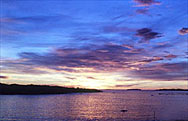April 14, 2000
Chuck Amsler
The bright haze over the ridge line of Wiencke Island and the mountains of the Antarctic Peninsula was more dusky orange, tinged with grayish blue, than it was golden. Still in the context of beauty rather than of physics, golden it was. The meadows were of macroalgae, undulating beneath the calm Southern Ocean surface we were crossing in the dawn's first glow. The elephant eyes were those of elephant seals, seen only at a distance as they slumbered along the shore as we gently motored out. But, oh. Oh what a beautiful morning! Today Katrin, Andy, Bill, Bruce, and I awoke to internal or external alarms at or a bit after 5:00 AM. At 6:00, when the first hint of dawn appeared in the eastern sky, we motored out from the Zodiac dock under a starry sky. We slowly picked and pushed our way through large bands of brash ice as we worked our way east to get around Bonaparte Point. Brash ice is composed of small remnants of sea ice and icebergs that get packed together by wind and current. Our destination was Laggard Island, the southern most island in the immediate area of the station. Once we finally cleared the last band if brash, Bruce was able to open throttle. We skimmed over the calm ocean surface with the first lights of dawn breaking over the mountains of Wiencke Island and the peninsula, just to the left of our course. This was not a dive trip. We were headed to collect in tide pools that lie on both sides of an isthmus that nearly splits Laggard it two. Low tide was at 5:30, but the tidal level at dawn would still be lower than we will have during daylight for the rest of our stay. The tides are irregular and uneven here. There are some great low tides coming up but all in the middle of the night. We needed low water for today's collections.
Our main quarry on this trip were amphipods. These are tiny crustaceans, related to but far smaller than shrimp. The larger ones are about a centimeter long. To catch them we normally go into tide pools and run aquarium nets over the patches of macroalgae. Katrin and I were in our dry suits so we could wade through the deeper water and Bruce was in hip waders. Andy and Bill were in normal field clothes for easier climbing around on the rocks above the pools.
The way it works is that the folks in dry suits or waders catch the animals. Then they hand the nets to someone on the rocks who empties them into large plastic jars for the trip home. We can usually catch a couple thousand in a fairly short time.
When we first got to the island it was still too dark to see well beneath the water. We were having very bad luck in our normal spots but didn't know if it was because the animals weren't active at night in nature (although they are in the lab), if we just couldn't get as low in the intertidal as we had before, or if something else might be different. Our luck only improved a bit when it got light until Bruce and Katrin found a large, protected tide pool with lots of medium sized rocks. Bruce would pick up a rock, spooking hundreds of amphipods that Katrin would then rapidly scoop up in a net. I went to help, and soon we had all the animals we needed. To get to this particular tide pool one had to wade through waist deep water so only Katrin, Bruce, and I could get there. Andy and Bill couldn't so they scouted out other spots for possible future collections. And why did we need a couple thousand tiny amphipods? The answer is for bioassays. As you know from reading other pages on the WOW site, we are studying chemical defenses against predators. To determine if an organism is chemically defended, we first have to see if predators eat it. If not, we extract chemical compounds from the alga or invertebrate and ask if they alone will deter a predator from eating something it otherwise would. We add the compounds to an artificial food that the predator normally eats and see if it still will eat the food. The experiments with both the intact organisms and the extracted compounds are called bioassays. We have developed three bioassays that we are using here now, and they will each be the focus of an upcoming journal entry. My next entry will be about the amphipod assay, which Jim and I developed. Andy will be telling you about an assay that uses sea stars. Jim conceived that several years ago. Katrin will tell you about an assay that she and Andy just finished developing for fish. By using three very different predators for bioassays we get a better idea of the breadth and depth of any defenses we identify than a single bioassay organism alone can tell us. We look forward to describing how we do all three soon. |






